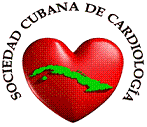Estimación del riesgo cardiovascular en la población cubana. Una aproximación al tema
Palabras clave:
riesgo cardiovascular, Factores de riesgoResumen
Introducción: La enfermedad cardiovascular es la principal causa de discapacidad y mortalidad en Cuba, cuyo envejecimiento es acelerado. Objetivo: estimar el riesgo cardiovascular global en la población cubana y determinar sus niveles por sexo, áreas geográficas y grupos de edad.
Método:Estudio descriptivo transversal cuyos datos provienen de la III Encuesta Nacional de Factores de Riesgo de Enfermedades no Trasmisibles, 2010-2011, representativa de la población de 15 años y más, por sexo y grupos de edad, en áreas urbanas y rurales. Se decidió utilizar las tablas de predicción del riesgo de la OMS/ISH. Las variables incluidas fueron: edad, sexo, consumo de tabaco, presión arterial, diabetes mellitus y colesterol total en sangre. El riesgo fue clasificado en: bajo(<10%), moderado(10-19,9%), alto(20-29,9%), muy alto(>=30%). Se calcularon frecuencias absolutas, porcentajes y sus IC 95%. Para las estimaciones a nivel de país se utilizó un factor de ponderación que lo permitiera.
Resultados: El 5.2 % de la población cubana tenía alto y muy alto riesgo cardiovascular, 8.6% riesgo moderado y 86% riesgo bajo. El riesgo mayor predominó en hombres y las mujeres predominaron en la categoría de bajo riesgo (89.4 vs. 81.8). Mayor riesgo de los hombres del área urbana. Globalmente se incrementó con la edad; en las mujeres a expensas del riesgo moderado; en los hombres a expensas del riesgo alto.
Conclusiones: La estimación del riesgo cardiovascular en la población cubana y la determinación de sus niveles contribuirán a direccionar acciones más efectivas de prevención y control. Se justifica el necesario esfuerzo por construir tablas nacionales de estimación del riesgo cardiovascular que se ajusten con mayor precisión a las características de la población cubana.
Descargas

Publicado
Cómo citar
Número
Sección
Licencia
Aquellos autores/as que tengan publicaciones con esta revista, aceptan los términos siguientes:- Los autores/as conservarán sus derechos de autor y garantizarán a la revista el derecho de primera publicación de su obra, el cuál estará simultáneamente sujeto a la Attribution-NonCommercial 4.0 Internacional (CC BY-NC 4.0) que permite a terceros compartir la obra siempre que se indique su autor y su primera publicación esta revista. o admite fines comerciales. Permite copiar, distribuir e incluir el artículo en un trabajo colectivo (por ejemplo, una antología), siempre y cuando no exista una finalidad comercial, no se altere ni modifique el artículo y se cite apropiadamente el trabajo original. El Comité Editorial se reserva el derecho de introducir modificaciones de estilo y/o acotar los textos que lo precisen, comprometiéndose a respectar el contenido original.
- Los autores/as podrán adoptar otros acuerdos de licencia no exclusiva de distribución de la versión de la obra publicada (p. ej.: depositarla en un archivo telemático institucional o publicarla en un volumen monográfico) siempre que se indique la publicación inicial en esta revista.
- Se permite y recomienda a los autores/as difundir su obra a través de Internet (p. ej.: en archivos telemáticos institucionales o en su página web) antes y durante el proceso de envío, lo cual puede producir intercambios interesantes y aumentar las citas de la obra publicada. (Véase El efecto del acceso abierto).








